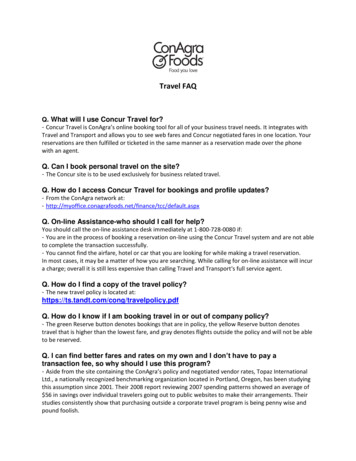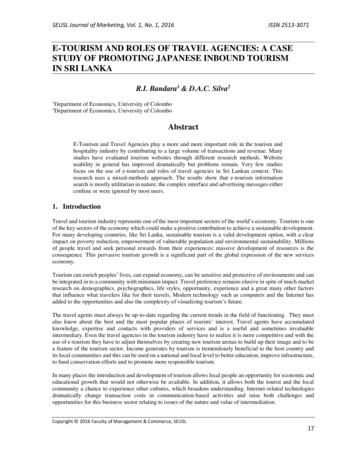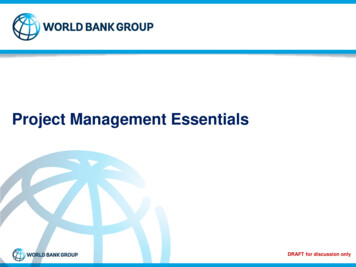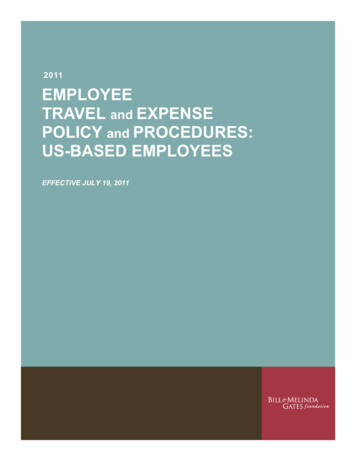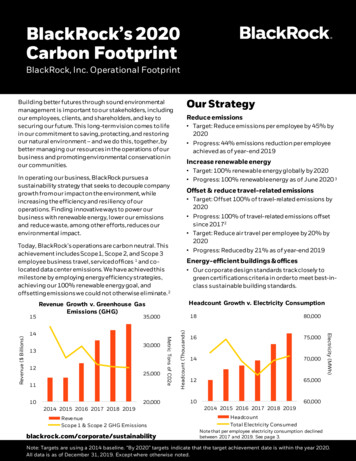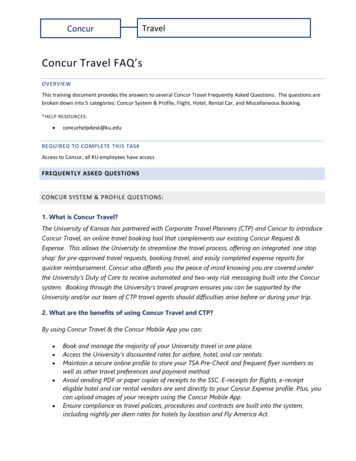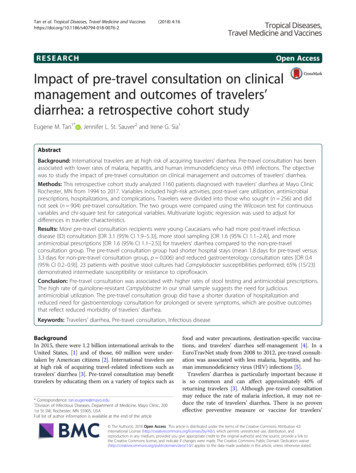
Transcription
Tan et al. Tropical Diseases, Travel Medicine and 2018) 4:16RESEARCHOpen AccessImpact of pre-travel consultation on clinicalmanagement and outcomes of travelers’diarrhea: a retrospective cohort studyEugene M. Tan1* , Jennifer L. St. Sauver2 and Irene G. Sia1AbstractBackground: International travelers are at high risk of acquiring travelers’ diarrhea. Pre-travel consultation has beenassociated with lower rates of malaria, hepatitis, and human immunodeficiency virus (HIV) infections. The objectivewas to study the impact of pre-travel consultation on clinical management and outcomes of travelers’ diarrhea.Methods: This retrospective cohort study analyzed 1160 patients diagnosed with travelers’ diarrhea at Mayo ClinicRochester, MN from 1994 to 2017. Variables included high-risk activities, post-travel care utilization, antimicrobialprescriptions, hospitalizations, and complications. Travelers were divided into those who sought (n 256) and didnot seek (n 904) pre-travel consultation. The two groups were compared using the Wilcoxon test for continuousvariables and chi-square test for categorical variables. Multivariate logistic regression was used to adjust fordifferences in traveler characteristics.Results: More pre-travel consultation recipients were young Caucasians who had more post-travel infectiousdisease (ID) consultation [OR 3.1 (95% CI 1.9–5.3)], more stool sampling [OR 1.6 (95% CI 1.1–2.4)], and moreantimicrobial prescriptions [OR 1.6 (95% CI 1.1–2.5)] for travelers’ diarrhea compared to the non-pre-travelconsultation group. The pre-travel consultation group had shorter hospital stays (mean 1.8 days for pre-travel versus3.3 days for non-pre-travel consultation group, p 0.006) and reduced gastroenterology consultation rates [OR 0.4(95% CI 0.2–0.9)]. 23 patients with positive stool cultures had Campylobacter susceptibilities performed; 65% (15/23)demonstrated intermediate susceptibility or resistance to ciprofloxacin.Conclusion: Pre-travel consultation was associated with higher rates of stool testing and antimicrobial prescriptions.The high rate of quinolone-resistant Campylobacter in our small sample suggests the need for judiciousantimicrobial utilization. The pre-travel consultation group did have a shorter duration of hospitalization andreduced need for gastroenterology consultation for prolonged or severe symptoms, which are positive outcomesthat reflect reduced morbidity of travelers’ diarrhea.Keywords: Travelers’ diarrhea, Pre-travel consultation, Infectious diseaseBackgroundIn 2015, there were 1.2 billion international arrivals to theUnited States, [1] and of those, 60 million were undertaken by American citizens [2]. International travelers areat high risk of acquiring travel-related infections such astravelers’ diarrhea [3]. Pre-travel consultation may benefittravelers by educating them on a variety of topics such as* Correspondence: tan.eugene@mayo.edu1Division of Infectious Diseases, Department of Medicine, Mayo Clinic, 2001st St SW, Rochester, MN 55905, USAFull list of author information is available at the end of the articlefood and water precautions, destination-specific vaccinations, and travelers’ diarrhea self-management [4]. In aEuroTravNet study from 2008 to 2012, pre-travel consultation was associated with less malaria, hepatitis, and human immunodeficiency virus (HIV) infections [5].Travelers’ diarrhea is particularly important because itis so common and can affect approximately 40% ofreturning travelers [3]. Although pre-travel consultationmay reduce the rate of malaria infection, it may not reduce the rate of travelers’ diarrhea. There is no proveneffective preventive measure or vaccine for travelers’ The Author(s). 2018 Open Access This article is distributed under the terms of the Creative Commons Attribution 4.0International License (http://creativecommons.org/licenses/by/4.0/), which permits unrestricted use, distribution, andreproduction in any medium, provided you give appropriate credit to the original author(s) and the source, provide a link tothe Creative Commons license, and indicate if changes were made. The Creative Commons Public Domain Dedication o/1.0/) applies to the data made available in this article, unless otherwise stated.
Tan et al. Tropical Diseases, Travel Medicine and Vaccines(2018) 4:16diarrhea, which is why it continues to affect such a largeproportion of travelers [5].The objective of this study was to examine the impactof pre-travel consultation on clinical management andoutcomes of travelers’ diarrhea. The hypothesis was thatpatients with travelers’ diarrhea who received pre-travelconsultation would have improved clinical outcomescompared to those without pre-travel consultation. Specific aims included comparing high-risk travel behaviorsas they relate to food and water consumption, itineraries,and hospitalization and complication rates for travelerswith and without pre-travel consultation.Page 2 of 8(n 46) of patients who sought pre-travel consultationoutside the Mayo TTMC, they were included in thesame group as the Mayo pre-travel consultation recipients for statistical analysis.DemographicsDemographic information included age, gender, ethnicity, employment, and local residence (i.e., residing inOlmsted County). Destinations of travel were recordedbased on the classifications provided by the GeoSentinelSurveillance System (Fig. 1) [7]. These categories werenot mutually exclusive because travelers often visitedmultiple destinations.MethodsStudy design, period, and areaTravel itinerariesThis single-center retrospective cohort study includedpatients of all ages who received medical care for travelers’ diarrhea at Mayo Clinic Rochester, MN, USA, between January 1, 1994, and December 31, 2016.Travelers’ diarrhea was defined as the passage of threeor more unformed stools in a 24-h period within 10 daysof return from international travel [6]. Persons thatgranted permission for their medical records to be usedfor research (Minnesota Research Authorization) wereincluded in the study, which was approved by the MayoClinic Institutional Review Board.All patients with travelers’ diarrhea were identifiedthrough the Advanced Cohort Explorer (ACE), which isan institutional search engine that located 7025 chartscontaining various spellings and capitalizations of thekeyword travelers’ diarrhea. We also searched for “infectious gastroenteritis and colitis, unspecified” (ICD-10diagnosis code A09); “diarrhea, unspecified” (ICD-10diagnosis code R19.7); “enterotoxigenic Escherichia coliinfection” (ICD-10 diagnosis code A04.1); and “infectious diarrhea” (ICD-9 diagnosis code 009.2). As thesediagnosis codes were not specific for travelers’ diarrhea,we then searched for keywords referencing internationaltravel. Charts were manually reviewed and excluded ifthe keyword travelers’ diarrhea was stated only in thecontext of pre-travel consultation, not for post-travel illness. Patients identified as having travelers’ diarrhea associated with domestic travel only were excluded. Theseinclusion and exclusion criteria yielded the final samplesize of 1160 patients with travelers’ diarrhea.These patients were subdivided into those who had (n 256) and those who did not have (n 904) pre-travelconsultation. Pre-travel consultation is provided by theTravel and Tropical Medicine Clinic (TTMC) within theDivision of Infectious Diseases (ID) at Mayo Clinic. Outof the 256 patients in the pre-travel consultation group,210 received their consultation at the Mayo TTMC, andthe remaining 46 received their consultation through aprimary care provider. Given the relatively small numberInformation on itineraries included travel reason, destination, and duration. High-risk travel was defined as anyactivity that may increase the risk of food/waterborne illness, such as consuming unsanitary food (e.g. undercooked meat, unwashed fruits, or salads) or drinking tapwater, traveling to a rural area without ready access tohealth care, and camping or hiking in a remote areawhere there may not be access to potable water or hygiene facilities.Pre-travel counseling utilizationPre-travel consultation at the TTMC follows a standardized protocol that includes education on safe food andwater consumption, avoidance of high-risk travel activities, recommendations for appropriate vaccines, andprovision of antidiarrheal antibiotics for self-treatment.Vaccine recommendations were based on the travel itinerary and patient’s medical and immunization history,following Centers for Disease Control and Prevention(CDC) guidelines [8]. International travelers to developing countries often are advised to receive the hepatitis Aand typhoid fever vaccines. Preventive medication prescriptions included antibiotics (azithromycin or quinolones) for presumptive treatment of travelers’ diarrhea.For those who did seek pre-travel consultation, prescription rates of vaccines and antidiarrheal antibiotics wererecorded. In addition to the index episode of travel,utilization of pre-travel consultation for later and pastepisodes of travel was recorded. A portion of pre-travelconsultation recipients (18%, 46/256) received their consultation outside the Mayo TTMC; if these outside consultation notes documented similar discussion points asour Mayo TTMC notes, these patients were deemed ashaving completed pre-travel consultation.Travelers’ diarrhea: Clinical management and outcomesAfter returning with travelers’ diarrhea, patients presented for medical care in various settings: non-visit care(i.e. telephone or patient online service correspondence),
Tan et al. Tropical Diseases, Travel Medicine and Vaccines(2018) 4:16Page 3 of 8Fig. 1 Geographic region of exposure based on GeoSentinel Surveillance System [7] (All material in the Morbidity and Mortality Weekly Report(MMWR) Series is in the public domain and may be used and reprinted without permission)primary care, emergency or urgent care, ID, or othersubspecialty clinic. In the course of the post-travel medical evaluation, stool samples may be obtained for testing, and the microbiology of infection was recorded ifdocumented.As our study period ranged from 1994 to 2017, therewere changes in diagnostic testing during this long timeframe. Though conventional stool culture was the solemethod of testing for many years, our institution implemented a limited bacterial enteric pathogen polymerasechain reaction (PCR) panel on August 23, 2010, whichtested for only Campylobacter, Shigella, E. coli, Yersinia,and Salmonella. Clinicians had the option of ordering either the stool culture or the limited PCR panel, and thechoice of either test varied widely depending on the individual providers.On October 12, 2015, our institution implemented theGastrointestinal FilmArray Panel by BioFire, which is amultiplex PCR panel that detects twenty-two commonbacterial, parasitic, and viral gastrointestinal pathogens.As part of the new laboratory testing algorithm, stoolculture would only be performed if the BioFire panelwas negative and if diarrhea persisted. The type of stoolsampling (culture versus PCR) and the results of anysusceptibility panels were recorded, if available.Clinical management and outcomes were assessedthrough the following variables: antimicrobial prescriptions, development of Clostridium difficile infection afterantimicrobial use, hospitalization rate and duration,short-term complications (e.g. dehydration or acute kidney injury), long-term complications (chronic diarrhealasting over four weeks), and need for gastroenterologyconsultation.Data analysisDescriptive statistics were used to determine if travelercharacteristics, management of diarrhea, and diarrheaoutcomes differed between patients who did and did notutilize pre-travel consultation. Primary measures werecompared between the pre-travel and non-pre-travelconsultation groups using the Wilcoxon test for continuous variables and chi-square test for categorical variables. Multivariate logistic regression was used to adjustfor differences in traveler characteristics. JMP 13 Prowas used for statistical analysis.ResultsDemographicsCharacteristics of patients with travelers’ diarrhea whodid and did not utilize pre-travel consultation are shownin Table 1. Patients who utilized pre-travel consultationwere younger and more likely to be students. There wasa high proportion of Caucasians in both pre-travel andnon-pre-travel consultation groups (Table 1).Travel itinerariesThe major destination for travelers returning with diarrhea was Central America, specifically Mexico, of whom
Tan et al. Tropical Diseases, Travel Medicine and Vaccines(2018) 4:16Table 1 Demographics of patients with travelers’ diarrhea (n 1160)aPre-travel consultationPage 4 of 8Table 3 Travel characteristicsbPre-travel consultationap valueYes (n 256)No (n 904)Age, in years35 (23–53)43 (27–56)0.0001Days of travelcMale107 (42)413 (46)0.3Reasons:Employed153 (60)626 (69)0.0004p valuebYes (n 256)No (n 904)15 (9–32)8 (7–14) 0.0001Vacation83 (32)379 (42)0.006Unemployed103 (40)278 (31)Business54 (21)55 (6) 0.0001Student64 (25)102 (11)Volunteer work68 (27)33 (4) 0.0001dRetired16 (6)106 (12)VFR38 (15)61 (7) 0.0001Other23 (9)70 (8)Unknown13 (5)376 (42) 0.0001Caucasian208 (81)794 (88)0.007Unsanitary food65 (24)189 (21)0.07Local residentc177 (69)529 (59)0.002Unsanitary water39 (15)104 (12)0.00032116 (13) 0.0001Rural location137 (54)39 (4) 0.0001Hiking42 (16)15 (2) 0.0001Camping25 (10)2 (0.2) 0.0001Traveler sought pre-travelconsult for future travel92 (36)Traveler sought pre-travelconsult for prior travel60 (23)116 (13) 0.0001aaContinuous variables are expressed as median (interquartile range). IQR interquartile range from the 25th percentile to the 75th percentile. Categoricalvariables are expressed as numbers (%)bP values were calculated based on Pearson’s chi-square test for categoricalvariables and Wilcoxon’s rank sum test for continuous variablescLocal residents were defined as those whose primary residence was inOlmsted County, Minnesota, at the time of travelthe majority (565/904, 63%) did not seek pre-travel consultation. In contrast, for more distant destinations suchas South America, Sub-Saharan Africa, and South Asia,more patients with travelers’ diarrhea did seek pre-travelconsultation (Table 2).A greater percentage of vacation travelers did not seekpre-travel consultation, whereas a higher percentage ofbusiness, volunteer, and visiting friends and relatives(VFR) travelers sought pre-travel consultation (Table 3).Information on duration of travel was available for only47% (542/1160) patients. Those who sought pre-travelTable 2 Travel destinations based on geographic regions, asdefined by the GeoSentinel Surveillance Network, for patientswith travelers’ diarrhea (n 1160). Travelers often frequentedmultiple destinationsRegionCentral AmericaMexicoPre-travel consultationaYes (n 256)No (n 904)55 (22)565 (63)p valueb 0.000117 (7)494 (55)South America36 (14)51 (6) 0.0001Sub-Saharan Africa65 (25)20 (2) 0.0001South Asia42 (16)32 (4) 0.0001Southeast Asia36 (14)31 (3) 0.0001Northeast Asia20 (8)31 (3)0.0080Caribbean23 (9)117 (13)0.2aCategorical variables are expressed as numbers (%)bP values were calculated based on Pearson’s chi-square test forcategorical variablesCategorical variables are expressed as numbers (%)bP values were calculated based on Pearson’s chi-square test for categoricalvariables and Wilcoxon’s rank sum test for continuous variablescDuration of travel was recorded as a continuous variable, which wasexpressed as median (interquartile range). IQR interquartile range from the25th percentile to the 75th percentile. Information on duration of travel wasavailable for only 47% (542/1160) patientsdVFRs are immigrants or the children of immigrants, who are from developingnations and return home to visit friends and relativesconsultation traveled for longer durations, traveling almost twice as long as those who did not seek pre-travelconsultation. Patients with travelers’ diarrhea reportedvarious high-risk activities. There were higher percentages of all high-risk activities, such as unsanitary foodand water consumption, in the pre-travel versus thenon-pre-travel consultation group (Table 3).Pre-travel counseling utilizationAbout three-quarters (78%) of those reporting travelers’ diarrhea did not receive pre-travel consultation. Of those patients who received pre-travel consultation, a majority (220/256, 86%) received prescriptions for antidiarrheal antibioticsbefore departure. These pre-travel antibiotic prescriptions included quinolones (144/256, 66%) and azithromycin (76/256,35%). Depending on destination-specific risk factors for disease, hepatitis A and typhoid fever vaccines were recommended to most, but not all, travelers who sought pre-travelconsultation. The pre-travel consultation group had a higherrate of hepatitis A vaccine completion [53% (134/255)] compared to the non-pre-travel consultation group [20% (177/868), p 0.0001]. The pre-travel consultation group also hada higher rate of typhoid fever vaccine completion: [72%(169/234)] compared to the non-pre-travel consultationgroup [5% (41/839), p 0.0001]. Patients who soughtpre-travel consultation prior to the index episode of travelers’diarrhea had higher rates of both future and past pre-travelconsultations, compared to the non-pre-travel consultationgroup (Table 1).
Tan et al. Tropical Diseases, Travel Medicine and Vaccines(2018) 4:16Travelers’ diarrhea: Clinical management and outcomesAfter returning from travel (Table 4), patients who did nothave pre-travel consultation presented to primary care providers (39%) more than those who did (29%, p 0.0001).Those who sought pre-travel consultation had higher ratesof post-travel specialty ID consultation (34% in pre-travelconsultation group versus 9% in non-pre-travel consultation group, p 0.0001). Non-visit care, such as telephoneor patient online correspondence, was a common way forpatients in both groups to seek medical advice.A greater percentage (52%) of the pre-travel consultation group had stool samples sent for microbiologictesting, compared to the non-pre-travel consultationgroup (37%, p 0.0001). Of those who had stool testingdone in both groups, Campylobacter species (38/114,33%) were the most common bacterial pathogens,followed by Escherichia coli (22/114, 19%) and Salmonella species (22/114, 19%).Page 5 of 8When diagnosed with travelers’ diarrhea, a greaterpercentage (73%) of the pre-travel consultation group hadantimicrobials prescribed, compared to the non-pre-travelconsultation group (62%, p 0.002). Overall, a smallproportion of individuals in both groups (6–7%) requiredhospital admission. Though there was no significantdifference in rates of hospitalization between the twogroups, the duration of hospitalization was shorter in thepre-travel consultation group (median 1 day) compared tothe non-pre-travel consultation group (median 2 days,p 0.02). There were no significant differences inshort-term complications, which included dehydrationand acute kidney injury, nor in chronic diarrhea (lasting 4 weeks) between the two groups. Of those withchronic diarrhea, more patients in the non-pre-travelconsultation group (55%) saw a gastroenterology specialist compared to the pre-travel consultation group(26%, p 0.0004).Table 4 Clinical management and outcomes of travelers’ diarrheaPre-travel consultationap valuebYes (n 256)No (n 904)Primary Care73 (29)348 (39)Infectious Disease (ID)39 (15)38 (4)Emergency/Urgent Care32 (13)137 (15)Other Specialtyc13 (5)89 (10)Non-Visit Cared99 (39)292 (32)1st health care encounter 0.0001ID consultation86 (34)82 (9) 0.0001Stool sample134 (52)331 (37) 0.0001Pathogens found34/134 (25)80/331 (24)0.8Campylobacter10/34 (29)28/80 (35)0.6Escherichia coli5/34 (15)17/80 (21)0.4Salmonella5/34 (15)17/80 (21)0.4Shigella2/34 (6)3/80 (4)0.6Giardia6/34 (18)6/80 (8)0.1Post-travel antimicrobial prescribede187 (73)563 (62)0.002Clostridium difficile infection after antimicrobials4/187 (2)9/563 (2)0.6Hospitalization17 (7)53 (6)0.6Microbiology:Number of hospital days1 (1–2)2 (1–4)0.02Short-term complications32 (13)100 (11)0.5Diarrhea lasting 4 weeks50 (20)155 (17)0.4Gastroenterology consultation13/50 (26)85/155 (55)0.0004aCategorical variables are expressed as numbers (%). Continuous variables are expressed as median (interquartile range). IQR interquartile range from the 25thpercentile to the 75th percentileP values were calculated based on Pearson’s chi-square test for categorical variablescOther specialties included gastroenterology, endocrinology, cardiology, transplant, surgery, etcdNon-visit care included telephone calls or patient online correspondence between patients and providersePost-travel antimicrobials were prescribed either empirically or based on microbiology results, if available. Common post-travel antimicrobials includedazithromycin and ciprofloxacinb
Tan et al. Tropical Diseases, Travel Medicine and Vaccines(2018) 4:16Table 5 shows the results of multivariate analyses performed to adjust for differences in baseline traveler characteristics, such as age, sex, race, travel destination, andhigh-risk behaviors. The fully adjusted multivariatemodel showed that the pre-travel consultation grouphad more ID consultation, less gastroenterology consultation, more stool samples obtained, more antimicrobialsprescribed, and shorter hospital stay.Drug resistanceStool pathogens were isolated from 114 patients with travelers’ diarrhea in both the pre-travel and non-pre-travelcounseling groups. Campylobacter species were detectedin 38 (33%) samples: 87% (33/38) were isolated throughstool culture, whereas the remaining 13% (5/38) were detected through polymerase chain reaction (PCR) only.Susceptibility testing on 23/33 (70%) on the isolates fromstool cultures showed 65% (15/23) of Campylobacter isolates with intermediate susceptibility or resistance to ciprofloxacin, as defined by a minimum inhibitoryconcentration greater than or equal to 2 μg/mL [9].Among this small sample (n 15) of patients withciprofloxacin-resistant Campylobacter species, the majoritytraveled to Mexico (6, 40%); other destinations includedDominican Republic (2, 14%); Belize, Tanzania, Venezuela,Colombia, Bolivia, Peru, and Jamaica (each with 1 case,7%). All of these patients with quinolone-resistant Campylobacter species had resolution of their diarrhea. 67%(10/15) were treated with azithromycin, based on susceptibility results. Interestingly, despite quinolone resistance,13% (2/15) experienced resolution of symptoms with ciprofloxacin treatment, and 20% (3/15) experienced resolutionwith no antimicrobials at all.DiscussionPre-travel consultation recipients had increased rates ofpost-travel ID consultation, stool testing, and antimicrobialPage 6 of 8prescriptions for travelers’ diarrhea. However, the pre-travelconsultation group had a reduced duration ofhospitalization and need for subsequent gastroenterologyconsultation for prolonged or severe symptoms; this mayhave reduced the overall long-term morbidity of disease.DemographicsThe pre-travel consultation group was largely characterized by young Caucasians. The younger age range maybe explained by the greater proportion of students in thepre-travel consultation group. Often, students who travelfor educational, volunteer, or religious purposes are required by their school or organization to seek pre-travelconsultation. The large number of patients in this studywho did not seek pre-travel consultation is consistentwith the previous finding that up to 80% of travelers donot seek pre-travel consultation [10]. This suggests theneed for additional education for potential travelers onthe utility of pre-travel consultation, particularly whentraveling to destinations that carry a high risk for acquiring travel-related illnesses. The pre-travel consultationgroup’s higher rates of past and later pre-travel consultations attests to the value that these patients obtainedfrom these visits.Travel itinerariesThe most popular travel destination was Central America, specifically Mexico, for which many travelers did notseek pre-travel consultation; this may be associated withthe greater proportion of vacation travelers. For fartherdestinations such as South America, Sub-Saharan Africa,and South Asia, a greater proportion of travelers didseek pre-travel consultation, which may be associatedwith the greater proportion of business and volunteerwork travelers. Though the reason for this discrepancyin pre-travel consultation rates among vacation, business, and volunteer work travelers is unknown, theseTable 5 Multivariate analysis for clinical management and outcome variablesPre-travel consultation (compared to no pre-travel consultation)aUnadjusted odds ratio(95% confidence interval)Partially adjusted odds ratio(95% confidence interval)bFully adjusted odds ratio(95% confidence interval)cInfectious Disease Consult5.1 (3.6–7.2)5.4 (3.8–7.7)3.1 (1.9–5.3)Gastroenterology Consult0.3 (0.1–0.6)0.2 (0.1–0.5)0.4 (0.2–0.9)Mean Days of Hospitalizationp 0.009p 0.06p 0.0061.8 days1.8 days1.8 daysPre-travel consult3.3 days3.3 days3.3 daysStool sample obtainedNo pre-travel consult1.9 (1.4–2.5)1.9 (1.4–2.5)1.6 (1.1–2.4)Antimicrobial prescribed1.6 (1.2–2.2)1.7 (1.2–2.3)1.6 (1.1–2.5)aA nominal logistic model was used for categorical variables. Least squares means were used to estimate the mean hospitalization duration based on a linearmodel. P values were calculated based on least squares meansbPartially adjusted model included age, sex, and racecFully adjusted model included age, sex; race; local residence; employment; travel destinations (Central America, South America, Sub-Saharan Africa, South Asia,Southeast Asia, Northeast Asia, Caribbean); unsanitary food and water consumption; rural location; hiking; camping
Tan et al. Tropical Diseases, Travel Medicine and Vaccines(2018) 4:16findings are consistent with a past study on pediatrictravel consultation, in which patients seen in travel clinicwere more likely to travel for humanitarian work or parental work relocation, whereas vacation travelers weremore likely to be seen in a general medical clinic [11].The hypothesis was that the pre-travel consultationgroup would demonstrate lower rates of participation inhigh-risk activities, such as unsanitary food and waterconsumption. Paradoxically, however, the opposite association was found. It is possible that these risk factors werenot modifiable in the pre-travel consultation group, as thisgroup did plan longer, more distant, more rural, and potentially higher-risk itineraries. There may simply not havebeen easy access to clean food or water available in someof the destinations that the pre-travel consultation groupfrequented. This finding is consistent with past observations, which have shown that rates of travelers’ diarrheahave not changed significantly over a 50-year period despite pre-travel counseling. Travelers may have a limitedability to select places serving food based on hygiene, andpre-travel advice regarding avoidance of certain foods maybe too difficult and impractical to follow [12]. Anotherpossibility is that the pre-travel consultation group trulydid engage in higher-risk activities, as the provision of a“safety net” of antidiarrheal medications prescribed duringtheir pre-travel consultation may have subconsciously created a sense of complacency in this group.Travelers’ diarrhea: Clinical management and outcomesPre-travel consultation at Mayo Clinic is offered by the Division of Infectious Diseases (ID). Therefore, those travelerswho seek pre-travel consultation are connected to care withthe ID division and may be more likely to seek ID consultation for post-travel illness or future travel-related medicalissues. This finding is reflected in Table 1, which shows thata greater proportion of patients with travelers’ diarrhea andpre-travel consultation utilized ID services post-travel. Thisspecific demographic may have demonstrated more healthcare-seeking behavior at baseline, possibly due to morecomprehensive insurance plans. However, as insuranceexpenses and out-of-pocket costs were not measured, it isdifficult to draw a specific conclusion.The association of ID consultation with favorable clinicaloutcomes supports a potentially important role of the IDphysician in the management of travelers’ diarrhea. Patientsin the pre-travel consultation group had improved outcomescompared to the non-pre-travel consultation group. For example, the pre-travel consultation group had a shorter duration of hospitalization. Although there was a statisticallysignificant decrease in duration of hospitalization, the relatively small sample size and the median difference of onlyone day may not make this a clinically significant result.Stool testing may facilitate appropriate diagnosis andmanagement when patients return with severe symptoms.Page 7 of 8According to the 2017 Infectious Diseases Society ofAmerica (IDSA) Clinical Practice Guidelines for the Diagnosis and Management of Infectious Diarrhea, stool testingshould be performed for travelers to resource-challengedareas if they have severe or persistent symptoms or fail empiric therapy [13, 14].Though the pre-travel consultation group had a shorterduration of hospitalization and less need for gastroenterology consultation for prolonged or severe symptoms, it isuncertain if these positive outcomes were associated withthe higher rate of ID consultation, stool testing, and antimicrobial prescription. ID specialists may be ordering an excessive number of stool testing and antimicrobials forpatients in whom symptoms would resolve naturally.Though most patients with quinolone-resistant Campylobacter species experienced resolution of symptoms with azithromy
Travel and Tropical Medicine Clinic (TTMC) within the Division of Infectious Diseases (ID) at Mayo Clinic. Out of the 256 patients in the pre-travel consultation group, 210 received their consultation at the Mayo TTMC, and the remaining 46 received their consultation through a
